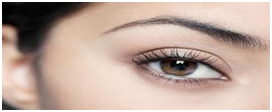
Cataract — Most Common Cause for Vision Loss
Eye disorder that can occur with little warning is a cataract, which is clouding of the lens within the eye. The lens is composed of water and protein. The protein is arranged so that light can pass through and focus on the retina. If the protein clumps together, however, it starts to cloud over a small area of the lens. In due course of time, this cloudy mass of protein — called a cataract — can grow larger, making it hard to see. That's when it becomes a problem.
Cataracts are painless. Often people with cataracts begin to complain about glare. "When these people have bright lights shined on them, their vision may drop rather dramatically." Colors may seem faded, and eyeglasses or contact lenses may need frequent changing. People with cataracts may need increased light to read.
If the cataract worsens surgery may be necessary to remove the cloudy lens and replace it with a new lens.
By the year 2020, there will be more than 12 million individuals in the 65 or older age group who will probably need treatment for cataracts.
Besides age, other factors that scientists believe may put individuals at greater risk for developing a cataract include heredity, alcohol use, smoking, long-term exposure to high levels of the sun's ultraviolet rays, some medications and systemic disorders such as diabetes.
The lens of eye is an important part of seeing clearly. It focuses light onto the retina. In cataract surgery, the affected lens is removed and, therefore usually needs to be replaced. Currently, there are three types of substitute lenses: an intraocular lens (IOL), a contact lens or cataract glasses. About 90 percent of people who need to replace their lens choose an IOL. Of them, about 90 percent achieve 20/40 vision or better.
- Intraocular lens: An IOL is a clear synthetic lens that is placed in the eye during cataract surgery. It requires no care. With an IOL, patients have better vision and won't feel or see the new lens. A few people cannot have an IOL because they're sensitive to the material the lens is made of, their eye structure isn't suitable, or they have certain other eye diseases.
Blindness– Global and Indian Scenario
Blindness- Global Scenario
This 1 billion people includes those with moderate or severe distance vision impairment or blindness due to unaddressed refractive error (88.4 million), cataract (94 million), age-related macular degeneration (8 million), glaucoma (7.7 million), diabetic retinopathy (3.9 million), as well as near vision impairment caused by unaddressed presbyopia (826 million).
- Approximately 411 million people worldwide live with low vision and blindness.
- Of these, 45 million people are blind and 269 million have low vision.
- Low vision of 145 million people is due to uncorrected refractive errors and could be restored with eye glasses.
- 80% of blindness is avoidable - i.e. readily treatable and/or preventable.
- An estimated 1.4 million children under the age of 15 are blind worldwide.
- In some developing countries, up to 60% of children die within a year of becoming blind, either from the condition that caused the blindness (such as measles and vitamin A deficiency) or from inadequate care as families affected by poverty struggle to look after a disabled child.
- Blindness is both a cause and a result of poverty. Adults and children living in poverty are more likely to suffer from malnutrition, poor water quality and inadequate sanitation. This places them at much higher risk of contracting eye diseases
- Around three-quarters of the world’s blind children live in developing countries in Africa and Asia.
- The annual global economic impact of blindness is estimated at US$45 billion.
- Women face a significantly greater risk of vision loss than men.
- Nearly two thirds of blind people worldwide are women & girls.
- About 28000 new cases of cataract are reported everyday worldwide.
Blindness- Indian Scenario
Currently, there are an estimated 4.95 million blind persons and 70 million vision impaired persons in India, out of which 0.24 million are blind children. Early detection and treatment of the leading causes of blindness such as cataract are important in reducing the prevalence of blindness and vision impairment. There are significant developments in the field of blindness prevention.
- India has the greatest number of blind people in the world and currently about 19 million blind people live in India of which 80% live in rural and slum areas. Unfortunately, this number is increasing everyday.
- The problem is acute in the rural India particularly in the age group of 60 years and above.
- Backlog of patients suffering from eye – diseases especially cataract is huge and increasing and unfortunately Govt. Hospitals / eye surgeons in the districts are not able to cope with this challenge.
- Long distances from remote and backward areas to cities where hospitals are situated prevent patients to receive treatment.
- Private Doctors /Nursing Homes are beyond the reach of general masses to afford financially.
- Most of the agencies working in this field are reluctant to reach out the rural and slum population.
- Ignorance that blindness is the effect of old age and it is not curable. Also poor and old people have fate and destiny solace when becoming blind.
- Due to degenerating family values, there is general apathy towards aged parents regarding their health and treatment especially of the eyes.
Niramaya Trust takes the help of Media to bring awareness among common public about various vulnerable conditions/events/Occasions affecting eye health.
Try to bring ads on local T.V. Channel-
Support with slogans.



